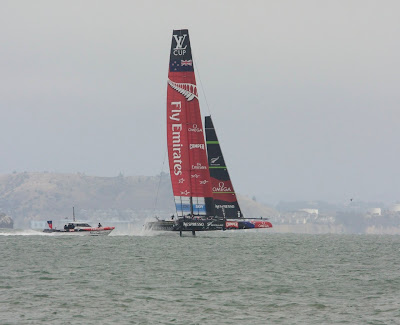 |
| I could only capture the two boats together at the start. After that they were never close together again |
You may recall that we went to see some sailboat racing a few months ago. Yesterday we braved the foggy San Francisco weather again to see the Louis Vuitton Cup races on the San Francisco Bay. If you haven't been following sailing, you may be excused for not knowing that 3 years ago team BMW/Oracle won the America's Cup in the Mediterranean Sea and now team Oracle is hosting the challengers to the oldest active trophy in international sports, here in the San Francisco Bay. The America's Cup is a match race between two boats; the defender and the challenger. The defender is the last winner and current holder of the cup. They get to write the rules for the next competition. The challenger, who will compete against the Team Oracle and the Golden Gate Yacht Club in this case, is being decided through a series of races called the Louis Vuitton Cup. Whoever wins that series of races will compete against Team Oracle in September in the America's Cup.
I have two sporting events that I try to follow; the Tour De France and the America's Cup. Both have been difficult to watch in the last few years. Just as it appears that Tour De France has been decided by doctors with pharmaceuticals, the America's Cup is decided by lawyers. There are constant challenges to the rules and court decision that have a significant effect on the outcome of the race. It feels like something where deals are struck in smokey back rooms.
Still, I am mesmerized and watch. The technology in these boats is crazy. I first got interested in the America's cup as a boy many years ago when the boats were 12 meter, mono-hull sailboats. Now they are carbon fiber miracles with wings for sails that literally fly over the water at 40 knots (~45mph) in a 20 knot (~23mph) breeze. When you see a 70+ foot boat "foiling" (rise out of the water) using only wind power, it is invigorating. It is magical. And it is over much too fast as they sail out of view.
 |
| Team New Zealand "flying" over the water |
This brings us to the competition itself. There are three contenders for the Louis Vuitton cup; Emerates Team New Zealand, Italy's Luna Rossa Challenge and Sweden's Artemis Racing. Artemis Racing had an accident in which their boat was heavily damaged and sadly one crew member died. They are rebuilding their boat, but in the mean time there are only two contenders for the Louis Vuitton Cup. Those are the two we saw this weekend. Team New Zealand cleaned Luna Rossa's clock. New Zealand got an advantage at the start and never looked back. They were significantly faster on every point of sail. This led me to the weird perspective that Luna Rossa, flying along at 35 knots, was "slow." The boats we are used to sailing will do about 8-10 knots under ideal conditions. This bears very little resemblance to the sailing sport that I know.
 |
| The "slower" Luna Rossa speeding across the bay |
So far, the technology involved is compelling to me, including the TV coverage on Youtube which is interesting to watch. If you'd like to see for yourself, you can find the schedule of races here, and the America's Cup YouTube Channel is here. Or you can watch the recording of the race that we saw live here. I do hope the competition gets more interesting soon because this has the potential to be quite an exciting spectacle. All I know is that in September, I expect to knock another item off my life list if I get to attend an America's Cup race live.
For the gadgeteers in the crowd, you can see an inside view of the America's Cup boats through the eyes of the Maker Camp hangout below. They visited Team Oracle in a couple weeks ago and give you a little glimpse into the technology and expertise that goes into building a world class racing sailboat, like a sewing machine that can sew through carbon fiber sails.

No comments:
Post a Comment